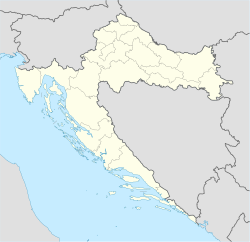Bedekovčina
Bedekovčina | |
|---|---|
| Coordinates: 46°02′00″N 16°00′00″E / 46.0333°N 16°E | |
| Country | |
| County | Krapina-Zagorje |
| Government | |
| • Mayor | Željko Odak (HDZ) |
| Area | |
• Total | 51.4 km2 (19.8 sq mi) |
| Population (2021)[2] | |
• Total | 7,340 |
| • Density | 140/km2 (370/sq mi) |
| Time zone | UTC+1 (CET) |
| • Summer (DST) | UTC+2 (CEST) |
| Website | bedekovcina |
Bedekovčina is a village and municipality in the Krapina-Zagorje County in Croatia. It is connected by the state road D24 and R201 railway. In the 2021 census, the total population of the municipality was 7,340.
History
[edit]The archaeological site of the Kiebel fortress is located in the area of the Bedekovčina Municipality. In 1248, the name of the noble town Castrum Cubul, which should be identified with the present-day toponym Kebel, first appears in written records. Almost twenty years later, in 1267, the Croatian-Hungarian King Bela IV granted Kumur, i.e. Komor in the then Varaždin County, to the Bedeković noble family. In 1543, in the War Tax List, we find estates owned by the Bedeković family: Komor, owned by Mihovil Bedeković, and Našenina (Naseyna), owned by Nikola Bedeković. Although the exact location of Našenina has not yet been determined, like Komor, it was located in the area of present-day Bedekovčina, which was named after its lords, the noble Bedeković family.
The Municipality of Bedekovčina was founded in 1940 by order of the Ban of the Banovina of Croatia, Ivan Šubašić. After World War II its development continued, and at the time Mače was also part of the Municipality of Bedekovčina. In 1960, the Municipality of Bedekovčina was abolished and was integrated into the Municipality of Zabok.
The municipality of Bedekovčina was reconstituted as an independent unit of local government in 1993, and its first mayor was Dragutin Burek. The area of today's Bedekovčina Municipality is divided between the parishes of Bedekovčina, Orehovica and Mača which played a major role in the development of settlements in the area of the Bedekovčina Municipality, especially since priests were the bearers and promoters of education. [3]
Demographics
[edit]In 2021, the municipality had 7,340 residents in the following 15 settlements:[2]
- Bedekovčina, population 3,119
- Belovar Zlatarski, population 98
- Brestovec Orehovički, population 305
- Grabe, population 391
- Kebel, population 345
- Križanče, population 122
- Lug Orehovički, population 214
- Lug Poznanovečki, population 594
- Martinec Orehovički, population 360
- Orehovica, population 226
- Poznanovec, population 887
- Pustodol Orehovički, population 272
- Vojnić-Breg, population 120
- Zadravec, population 98
- Židovinjak, population 189
| population | 3982 | 4549 | 5222 | 5677 | 6575 | 7690 | 7366 | 8169 | 9196 | 9043 | 8932 | 8742 | 8574 | 8773 | 8482 | 8041 | 7340 |
| 1857 | 1869 | 1880 | 1890 | 1900 | 1910 | 1921 | 1931 | 1948 | 1953 | 1961 | 1971 | 1981 | 1991 | 2001 | 2011 | 2021 |
In the 2021 census, the absolute majority were Croats at 98.68%.[2]
Administration
[edit]The current mayor of Bedekovčina is Željko Odak (HDZ) and the Bedekovčina Municipal Council consists of 13 seats.
| Groups | Councilors per group | ||||||||||||||||||||||||||||
| SDP-HSU-Reformists | 5 / 13
| ||||||||||||||||||||||||||||
| HDZ | 5 / 13
| ||||||||||||||||||||||||||||
| HNS | 3 / 13
| ||||||||||||||||||||||||||||
| Source:[4] | |||||||||||||||||||||||||||||
References
[edit]- ^ Register of spatial units of the State Geodetic Administration of the Republic of Croatia. Wikidata Q119585703.
- ^ a b c "Population by Age and Sex, by Settlements" (xlsx). Census of Population, Households and Dwellings in 2021. Zagreb: Croatian Bureau of Statistics. 2022.
- ^ "Povijest Bedekovčine". www.bedekovcina.hr. Retrieved 2025-07-08.
- ^ "II. KRAPINSKO-ZAGORSKA ŽUPANIJA" (PDF). State Election Committee of the Republic of Croatia. Retrieved 8 July 2025.
Literature
[edit]- Obad Šćitaroci, Mladen; Bojanić Obad Šćitaroci, Bojana; Dundović, Boris (2013). "Manors and Gardens in Northern Croatia in the Age of Historicism" (PDF). Centropa. pp. 175–186. ISSN 1532-5563. Archived from the original (PDF) on 2025-05-05. Retrieved 2025-03-19.


